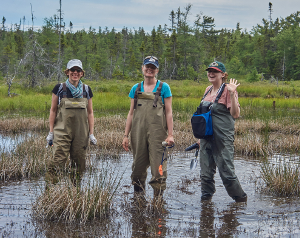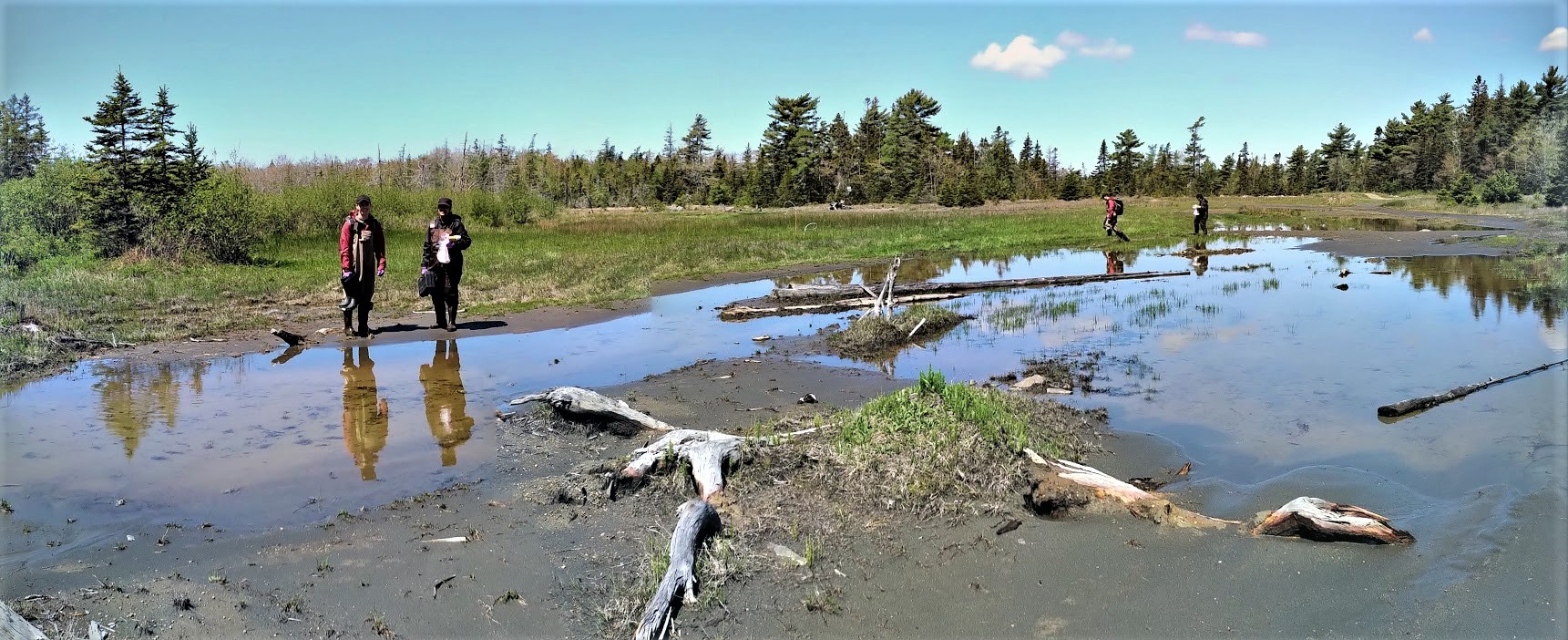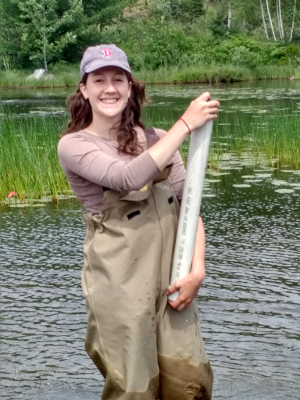Dynamic Environment & Ecosystem Health ResearchLegacy gold mine tailing contaminants |
 |
Home
People
Research
Historical gold mine tailings
- Ecology & biomonitoring
-Remediation
Invasive species
- Chinese mystery snails
- Chain pickerel
- Crayfish
Publications
Teaching
Resources & Links
Lab news
Media & updates
Directions
Approaching a century-old legacy of arsenic and mercury contamination.
Are you here about our mesocosm projects at Second Lake and Muddy Pond? Please see our remediation page for more information about our 5-year research project.
Waste materials ("tailings") from mining activities which took place in the 1800's can remain contaminated and toxic even over 100 years later. This is a national and international issue. The DEEHR group is developing biomonitoring and remediation approaches for impacts of those tailings on freshwater ecosystems and organisms which rely on those freshwater resources. Our focus is on Nova Scotia legacy gold mine tailings, and our goals are to develop methodology which can be used to remediate not only those sites but can also be applied to similar impacted sites around the world.
Nova Scotia has a long history of gold mining going back to the mid-1800's. There are over 360 gold mines in 64 historic gold mining districts in the Cambro-Ordovician Meguma Supergroup, stretching over a 300-km length of NS. Between 1862 and the mid-1940's, 1.2 million troy ounces of gold were extracted, typically using mercury amalgamation techniques. Due to a lack of environmental regulations in the 1800's, there is a modern legacy of three million tonnes of finely-ground contaminated waste tailings.
Mercury and arsenic remain elevated and of concern even 100 years later. Mercury-recovery techniques were practiced, but frequently 10 to 25% of mercury was lost to the environment through various means at each ore processing site. It has been conservatively estimated that a total of 3.7 to 9.1 tonnes of mercury may have been released to the NS environment from the 1850's to the 1940's. Since the original ore also included arsenopyrite and other arsenic-bearing pyrites, the gold-mine tailings also contain elevated arsenic. After processing, untreated tailings were frequently slurried into nearby freshwater systems without regard for the consequences. The legacy of localized tailing wastes near freshwater sites in 64 gold-mine regions has resulted in multi-generational chronic exposure to mercury, arsenic and other toxic elements for wildlife and humans. Many sites across Nova Scotia still bear the visible scars of this extensive mining and processing a century later.

We are doing something about this major environmental issue. There has been many excellent studies of arsenic and mercury exposure and impact in terrestrial ecosystems and geology. However, there is a significant knowledge gap for aquatic ecosystems of Nova Scotia, with only a few publications and reports on this topic.
The DEEHR team is carrying out several investigations looking at this significant environmental and industrial issue for Nova Scotia, in collaboration with NS Lands Inc., Atlantic Mining Nova Scotia, Natural Resources Canada, Nova Scotia Energy & Mines Geosciences Branch, Intrinsik Corp., and many others.
Our ecology and biomonitoring projects include:
- Studying the bioaccumulation and distribution of arsenic and mercury in living organisms across the province to assess the potential risk of gold mine tailing wastes to aquatic ecosystems.
- Biodiversity of wetlands impacted by contaminated historical tailings.
- Assessing dust, air and rain samples for mercury and arsenic from legacy gold mine tailings, including lichen collections.
- The potential of conifer dendrochronology and dendrochemistry analyses to assess mercury and arsenic fluxes.
- Paleoecology analyses of sediment cores for impacts of tailing contaminants.
- Establishing ecotoxicology testing of key species in the laboratory to examine the rate of bioaccumulation, speciation, reduced functionality and lethality of the toxic tailings.
- Developing a low-cost additive and capping methods to potentially significantly reduce the risk and toxicity of toxic gold mine tailings to terrestrial and aquatic biota as well as to humans.
- Using remote sensing, LiDAR and other tools to create spatial databases of the extent and distribution of legacy gold mine tailings in Nova Scotia.
- Rephotography project using historical photographs to assess changes through time since 1860's.

RESOURCES:
DEEHR Team & Collaborators Resources
- Digital Interactive ArcGIS Atlas of the Waverley Historical Gold Mine District. Bradley Knockwood. Link.
- ECAB Lab (Josh Kurek, Mt Allison). Using paleolimnology techniques to understand long-term impacts of historical gold mine tailings in freshwater ecosystems. Link.
- Brochure about contaminated historical gold mine tailing issues in Nova Scotia created by Peter Opra. Link to PDF file. (Created as a part of Clean Youth Internship outreach project).
- Dr. Emily Chapman's seminar on low-dose selenium additives for reducing toxicity of gold mine tailing waste to earthworms. Link to You-tube video.
- Molly LeBlanc's Three Minute Thesis talk "Not All That Glitters: Assessing Environmental Effects of Abandoned Gold Mines". Link to You-tube video. PDF transcript.
- Michael Smith, Linda Campbell & Carrie Rickwood. 2020. Lichens as biomonitors of dust and air quality biomonitors at a contaminated site. Research Proposal Poster. Saint Mary's University. Figshare. https://doi.org/10.6084/m9.figshare.12086661.v1.
- Michael Smith et al. 2020. Maps of sampling grids. Lichens as dust and air-quality biomonitors at a gold mine tailings site in Nova Scotia, Canada. Figshare. https://doi.org/10.6084/m9.figshare.12086205.v1.
- D. A. Jewell*, L. M. Campbell & H. P. White. 2024. An Exploration of False Positives Following Multispectral Analysis of Mine Tailings Extent. Canadian Journal of Remote Sensing. 50(1). Open Access. https://doi.org/10.1080/07038992.2024.2338357.
- D. A. Jewell*, H. P. White & L. M. Campbell. 2024.
Automated detection of mine tailings via object-based
classification of Sentinel-2 images. Geomatics Canada, Open
File, 79, 4. https://doi.org/10.4095/pgw1ywkvvm.
- AJ Clark, AL Labaj, JP Smol, LM Campbell & J Kurek. 2021. Arsenic and mercury contamination and complex aquatic bioindicator responses to historical gold mining and modern watershed stressors in urban Nova Scotia, Canada. Science of the Total Environment. 787:147374. https://doi.org/10.1016/j.scitotenv.2021.147374.
- BL Bowes. 2021. Examination of mercury and arsenic concentrations in spruce tree cores and soil samples from historical gold mine tailing sites in Nova Scotia. Honours thesis. Department of Environmental Science, Acadia University. PDF.
- EEV Chapman, C Moore & LM Campbell. 2020. Evaluation of a nanoscale zero-valent iron amendment as a potential tool to reduce mobility, toxicity, and bioaccumulation of arsenic and mercury from wetland sediments. Environmental Science and Pollution Research. Published online. https://doi.org/10.1007/s11356-020-08347-6. Read online: https://rdcu.be/b3cNZ.
- ME LeBlanc, MB Parsons, EEV Chapman & LM Campbell. 2020. Review of Ecological Mercury and Arsenic Bioaccumulation within Historical Gold Mining Districts of Nova Scotia. Environmental Reviews. https://doi.org/10.1139/er-2019-0042. Uncorrected proofs (PDF). CBC article about the review paper. Link.
- EEV Chapman, C Moore & LM Campbell. 2019. Native plants for revegetation of mercury and arsenic-contaminated historical mining waste - Can a low-dose selenium additive improve seedling growth and decrease contaminant bioaccumulation? Water, Air, & Soil Pollution. https://doi.org/10.1007/s11270-019-4267-x. Read online for free: https://rdcu.be/bP9M7.
- Molly LeBlanc. 2019. MSc Thesis. "Bioaccumulation and transfer of mercury and arsenic in aquatic invertebrates and emergent insects at historical gold mine tailing sites of Nova Scotia" Link to download page.
- EEV Chapman, J Robinson, J Berry & LM Campbell. 2016. Can a low-dose selenium (Se) additive reduce environmental risks of mercury (Hg) and arsenic (As) in old gold mine tailings? Water, Air, & Soil Pollution. https://doi.org/10.1007/s11270-016-2909-9 Read online for free: http://rdcu.be/mFfT.
External resources:
- Gold: A Nova Scotia Treasure. Comprehensive website resource. Link.
- Nova Scotia Archives "Men in the Mines: A History of Mining Activity in Nova Scotia, 1720-1992". Link.
- Nova Scotia DNR Geoscience & Mine Branch Maps, Reports & Data. Link.
- NovaScan Portal. Link.
- Dr. Michael Parsons et al. 2012. Environmental geochemistry of tailings, sediments and surface waters collected from 14 historical gold mining districts in Nova Scotia. Geological Survey of Canada. Link to PDF of Open File 7150 (note: large document, 326 pages).
- John Drage. 2015. NS DNR Open File. Review of Environmental Impacts of Historic Gold Mine Tailings in Nova Scotia. ME 2015-004. PDF Link.
- Alan L Sangster & Paul K Smith. 2003. Metallogenic Summary of the Meguma Gold Deposits, Nova Scotia. In: WD Goodfellow (ed) Mineral Deposits of Canada: A Synthesis of Major Deposit-Types, District Metallogeny, the Evolution of Geological Provinces, and Exploration Methods. Geological Association of Canada: Mineral Deposits Division. Special Publication No. 5. PDF Link.
- Dr. Michael Parsons's Atlantic Geoscience Society presentation
on Youtube: "Gold
Mining in Nova Scotia: Learning from the Past to Improve
Future Environmental Performance". June 2020. (no
captions, auto-captions are reasonable with several errors.)
- NS DNR Gold District GIS Data from E.R. Faribault (1898 - 1919) maps. Eastern Meguma; Western Meguma.
- eResearch Industry Report: Atlantic Gold Industry Report (Virginia to Newfoundland). March 5, 2021. PDF File.
- What do gold mine tailings look like? (PDF file from NS Environment). Link to PDF.
- HRM Advisory for Barry's Run, Dartmouth NS & legacy gold mine tailings from Montague. Halifax Regional Municipality informational website.
- Dillon Consultants. 2019. Halifax Regional Municipality Phase I/II Environmental Site Assessment Port Wallace, Dartmouth, Nova Scotia. PDF file (large document over 600 pages).
- Intrinsik Corp. 2020. Human health risk assessment of sediment, surface water, and fish from Barry's Run, Halifax Regional Municipality. (216 pages)
- NS Government NS Lands Inc - Request for Proposals Tender Details "FORMER GOLD MINE SITES MONTAGUE AND GOLDENVILLE - For Closure Concepts and Costs". Tender ID NSLAND97 (September 2018. Large document! 873 pages.)
- Intrinsik Corp et al. 2019. Conceptual Closure Plan for the Historic Goldenville Tailings Area. July 24, 2019. Large document (762 pages).
- Intrinsik Corp et al. 2019. Conceptual Closure Study for the Historic Montague Mine Tailings Areas. July 24, 2019. Large document (745 pages).
- NS Lands & Forests and NS Lands Inc. NS mining site clean-up priority list (as of March 11, 2020). PDF.
- Boston Public Library Digital Collections - historical maps of NS gold mine districts. Link.
- Historical documents associated with keywords "nova scotia gold" via the Internet Archive.
SELECTED MEDIA MENTIONS (for full list, go to this page.)
- Joint Mount Allison University - Saint Mary's University press release: SMU link, MtA ECAB link. See media page for reporting.
- SMU Press release: AMNS - SMU Partnership. Link. See media page for reporting.
- Port Wallace development & Montague legacy gold mine tailings. Halifax Examiner article by Joan Baxter. Link.
- CBC news article about Molly LeBlanc's review paper on As & Hg bioaccumulation in biological organisms in NS. Link.
- 95.7 interview by Katie Hartai with Dr. Chapman about developing an approach for remediation with local plants. Link. Transcript PDF Link.
- CBC News article about the NS Lands Inc RFP for Montague and Goldenville and Dr. Campbell's input: Link.
- Halifax Examiner article by Joan Baxter about legacy gold mine tailings in Nova Scotia: Link.
- CBC News article about the Public Service Announcement re: Barry's Run, Dartmouth and legacy gold mine tailings from Montague. Link.

Headings
- Legacy
of gold mining impacts in Nova Scotia.
- Mercury and arsenic issues.
- NS Gold Mine Contaminants
- Useful resources.

- Mercury and arsenic issues.
- NS Gold Mine Contaminants
- Useful resources.

All images and content
copyright (c) Linda Campbell and other members of Dynamic
Environment & Ecosystem Health Research Group. Map of
gold-bearing deposits is from the Canadian Geographic Magazine
(Sept/Oct 1994).